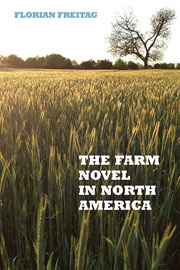 The Farm Novel in North America
The Farm Novel in North America Book contents
- Frontmatter
- Contents
- Acknowledgments
- Introduction
- 1 Surveying the Fields
- 2 Early Sowings: St. John de Crèvecocur's “History of Andrew, the Hebridean,” Patrice Lacombe's La terre paternelle, and Susanna Moodie's Roughing It in the Bush
- 3 Laws of Nature: Frank Norris's The Octopus, Albert Laberge's La Scouine, and Frederick Philip Grove's Settlers of the Marsh
- 4 New World Demeters: Willa Cather's O Pioneers!, Louis Hémon's Maria Chapdelaine, and Martha Ostenso's Wild Geese
- 5 Rich Harvests: Joseph Kirkland's Zury: The Meanest Man in Spring County, Claude-Henri Grignon's Un homme et son péché, and Frederick Philp Grove's Fruits of the Earth
- 6 Fields of Crisis: John Steinbeck's The Grapes of Wrath, Félix-Antoine Savard's Menaud, maître-draveur, and Robert J. C. Stead's Grain
- 7 The Cycle of Seasons: Louis Bromfield's The Farm, Ringuet's Trente arpents, and Grace Campbell's The Higher Hill
- Epilogue
- Works Cited
- Index
1 - Surveying the Fields
Published online by Cambridge University Press: 05 December 2013
- Frontmatter
- Contents
- Acknowledgments
- Introduction
- 1 Surveying the Fields
- 2 Early Sowings: St. John de Crèvecocur's “History of Andrew, the Hebridean,” Patrice Lacombe's La terre paternelle, and Susanna Moodie's Roughing It in the Bush
- 3 Laws of Nature: Frank Norris's The Octopus, Albert Laberge's La Scouine, and Frederick Philip Grove's Settlers of the Marsh
- 4 New World Demeters: Willa Cather's O Pioneers!, Louis Hémon's Maria Chapdelaine, and Martha Ostenso's Wild Geese
- 5 Rich Harvests: Joseph Kirkland's Zury: The Meanest Man in Spring County, Claude-Henri Grignon's Un homme et son péché, and Frederick Philp Grove's Fruits of the Earth
- 6 Fields of Crisis: John Steinbeck's The Grapes of Wrath, Félix-Antoine Savard's Menaud, maître-draveur, and Robert J. C. Stead's Grain
- 7 The Cycle of Seasons: Louis Bromfield's The Farm, Ringuet's Trente arpents, and Grace Campbell's The Higher Hill
- Epilogue
- Works Cited
- Index
Summary
The sheer variety of what happens on North American farms and of how these events are told in North American farm novels is truly astounding. Amid this variety of thematic issues, ethnicity of the cast of characters, and formal narrative aspects, however, there are also conspicuous constants or trends, which run along the lines of national literatures and cultures. Most importantly, American, English Canadian, and French Canadian farm novels, respectively, tend to portray specific types of farmers and to project particular national myths or ideologies onto the farm space. In the United States farm novels regularly focus on settlers who use the farm as a space to fulfill their personal version of the American dream. In English Canada, too, farm novels tend to focus on settlers, but here farmer characters regularly employ agriculture to project and impose their vision of man-made structures and order on the natural space. In French Canada, finally, the roman de la terre concentrates on well-established farmers and stresses the role of the farm space in the struggle for survival of French or French Canadian culture on the North American continent. Cross-border regional similarities—between, for instance, American and English Canadian farm novels from the West—notwithstanding, then, North American farm novels “differ in some nationally distinctive ways” (D. Harrison 1981, 259).
- Type
- Chapter
- Information
- The Farm Novel in North AmericaGenre and Nation in the United States, English Canada, and French Canada, 1845-1945, pp. 22 - 64Publisher: Boydell & BrewerPrint publication year: 2013
